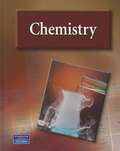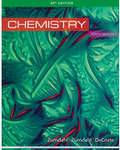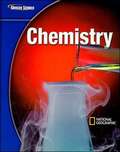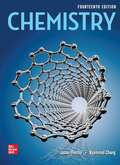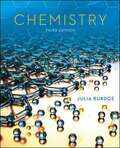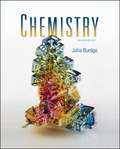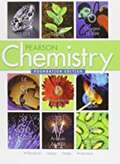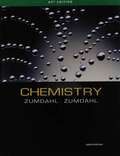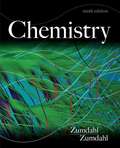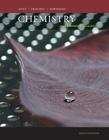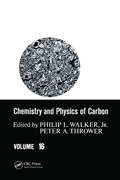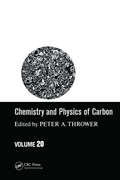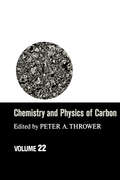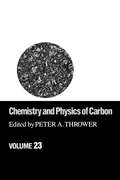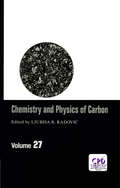- Table View
- List View
Chemistry
by Antony C. Wilbraham Dennis D. Staley Michael S. Matta Edward L. WatermanUse Virtual ChemLab to do almost any lab or procedure that can be performed in a real lab. Choose from 30 exciting pre-built labs or design your own in less time, and with no clean-up, safety, or equipment issues. Find realistic lab environments for Inorganic Chemistry, Calorimetry, Titrations, Gases, and Quantum Chemistry.
Chemistry
by Steven S. Zumdahl Susan A. Zumdahl Donald J. DeCosteLearn the skills you need to succeed in your chemistry course with CHEMISTRY, Tenth Edition. This trusted text has helped generations of students learn to “think like chemists” and develop problem-solving skills needed to master even the most challenging problems. Clear explanations and interactive examples help you build confidence for the exams, so that you can study to understand rather than simply memorize.
Chemistry
by Glencoe Mcgraw-HillDiscover the Flexibility to Teach Science Your Way!. "Glencoe Science: Chemistry," a module in the Glencoe Science 15 book series, provides students with accurate and comprehensive coverage of middle school National Science Education Standards. Concepts are explained in a clear, concise manner, and are integrated with a wide range of hands-on experiences, critical thinking opportunities, real-world applications, and connections to other sciences and to non-science areas of the curriculum. Co-authored by National Geographic, unparalleled graphics reinforce key concepts. A broad array of print and technology resources help differentiate and accommodate all learners. The modular approach allows you to mix and match books to meet your specific curriculum needs.
Chemistry
by Robert C. Fay Jill Kirsten Robinson John E. McMurryMcMurry/Fay/Robinson’s Chemistry, Seventh Edition, aims to help students understand the connections between topics in general chemistry and why they matter. The Seventh Edition provides a concise and streamlined narrative that blends the quantitative and visual aspects of chemistry, demonstrates the connections between topics, and illustrates the application of chemistry to their lives and careers. New content offers a better bridge between organic and biochemistry and general chemistry content, and new and improved pedagogical features make the text a true teaching tool rather than just a reference book. New MasteringChemistry features include conceptual worked examples and integrated Inquiry sections that help make critical connections clear and visible and increase students’ understanding of chemistry. The Seventh Edition fully integrates the text with new MasteringChemistry content and functionality to support the learning process before, during, and after class.
Chemistry
by Julia BurdgeChemistry, Third Edition, by Julia Burdge offers a clear writing style written with the students in mind. Julia uses her background of teaching hundreds of general chemistry students per year and creates content to offer more detailed explanation on areas where she knows they have problems. <p><p>With outstanding art, a consistent problem-solving approach, interesting applications woven throughout the chapters, and a wide range of end-of-chapter problems, this is a great third edition text.
Chemistry
by Julia R. BurdgeChemistry, Second Edition, by Julia Burdge has been created to bridge the gap in the McGraw-Hill general chemistry offerings. This textbook offers a clear writing style written with the students in mind. Julia uses her background of teaching hundreds of general chemistry students per year and creates content to offer more detailed explanation on areas where she knows they have problems.
Chemistry
by Pearson Prentice HallThis book helps students link their everyday encounters with chemical processes. Topic covered include: matter, change, scientific measurement, atomic structure, the periodic table and many more.
Chemistry
by Steven S. Zumdahl Susan A. ZumdahlAuthors Steven and Susan Zumdahl offer all the elements instructors need for their general chemistry course. They bring a conceptual approach to chemistry and integrate problem-solving skills throughout, helping students transition from theory to practice. A strong emphasis on models, real-world applications, and visual learning prevails throughout the text. The Seventh Edition seamlessly integrates the strengths of the Zumdahl approach through a comprehensive and interwoven print and technology program. Enhanced Sample Exercises, online homework problems, and Classroom Response System content help instructors assess conceptual understanding and problem-solving skills, while new animations and images support visual learning. In addition, Houghton Mifflin offers implementation services through our TeamUP program to help instructors and students get the most out of the text and its supplements. New! Reality Checks at the end of selected Sample Exercises prompt students to ensure that their answers are reasonable. New! The expanded art program includes new electrostatic potential maps in Chapter 8, "Bonding" that illustrate bond and molecular polarity. New! The redesigned For Review section now includes bulleted key concepts for the chapter, as well as review questions of which approximately 50% are new. New! Integrative Problems in the end-of-chapter material assess students' cumulative understanding of multiple concepts and skills presented in previous chapters. End-of-chapter questions also include collaborative Active Learning Question (formerly In-Class Discussion Questions), Exercises organized by topic, Additional Exercises not keyed by topic, integrative Challenge Problems, and comprehensive Marathon Problems. New! Algorithmically-generated Test Questions as well as Conceptual Questions are available in HM Testing, all coded by level of difficulty to allow instructors to more easily choose appropriate test items. New! Animations with assignable exercises appear on the Online Study Center and Student CD. New! HM ClassPresent v.3 includes new animations and videos as well as enhanced search functionality. Eduspace Online Learning Tool features two kinds of problems: ChemWork interactive online homework and end-of-chapter algorithmic questions with links to corresponding textbook pages and media for student reference at point of learning.
Chemistry
by Steven S. Zumdahl Susan A. ZumdahlSteven and Susan Zumdahl's CHEMISTRY 8e brings together the solid pedagogy, easy-to-use media, and interactive exercises that today's instructors need for their general chemistry course. Rather than rote memorization, CHEMISTRY emphasizes a thoughtful approach built on problem-solving. For the Eighth Edition, the authors have extended this approach by emphasizing problem-solving strategies within the Examples and throughout the text narrative. The text speaks directly to the student about how to approach and solve chemical problems--to learn to think like a chemist--so that they can apply the process of problem-solving to all aspects of their lives. Students are provided with the tools to become critical thinkers: to ask questions, to apply rules and develop models, and to evaluate the outcome.
Chemistry
by Steven Zumdahl Susan ZumdahlNever HIGHLIGHT a Book Again! Virtually all of the testable terms, concepts, persons, places, and events from the textbook are included. Cram101 Just the FACTS101 studyguides give all of the outlines, highlights, notes, and quizzes for your textbook with optional online comprehensive practice tests. Only Cram101 is Textbook Specific. Accompanys: 9781133611097 .
Chemistry & Chemical Reactivity
by John C. Kotz Paul M. Treichel John R. TownsendCHEMISTRY & CHEMICAL REACTIVITY, 7e, combines thorough instruction with powerful multimedia tools to give you a deeper understanding of general chemistry concepts. The book has a long-standing reputation for logical organization; macro to micro orientation; a superior art program; and state-of-the art media, which is expanded in the new edition. The text clearly emphasizes the visual nature of chemistry and illustrates the close interrelationship of the macroscopic, symbolic, and particulate levels of chemistry. With clear writing, seamless technology integration, and robust homework/assessment tools, CHEMISTRY & CHEMICAL REACTIVITY, 7e, equips you with tools to empower the mastery, assignment, and assessment of chemical principles. The text's art program reveals these three levels in engaging detail--and is fully integrated with new key media components. The Web-based tutorial CengageNOW(tm) generates a personalized study plan to meet your specific needs and includes Go Chemistry mini video lectures and flash cards that offer the perfect quick review for students on the go. Fully customizable OWL is a Web-based homework system that maximizes study time and offers an optional e-book. With hundreds of guided simulations, animations, video clips, and more, CHEMISTRY & CHEMICAL REACTIVITY, 7e, is more completely integrated with accompanying technology than any other text on the market.
Chemistry & Chemical Reactivity, Enhanced Review Edition
by John C. Kotz Paul M. Treichel Gabriela C. WeaverNIMAC-sourced textbook
Chemistry & Earth Systems
by Discovery EducationScience Techbook for the California NGSS fully supports the instructional shifts required by the CA NGSS standards and embraces the philosophy of three-dimensional teaching and learning.--Publisher website
Chemistry & Physics of Carbon: Volume 16
by Philip L. WalkerThis book provides insights into the mechanisms of primary carbonization, discusses changes in the thermal-mechanical properties of carbon/carbon composites due to stress effects. It describes factors that result in the acceleration of the graphitization process.
Chemistry & Physics of Carbon: Volume 19
by Peter A. ThrowerThis volume reviews the evidence for some elements substituting directly for carbon atoms in the graphite lattice. It is an invaluable resource to all carbon researchers and to those who involved with graphite materials, and serves to provoke research.
Chemistry & Physics of Carbon: Volume 20 (Chemistry And Physics Of Carbon Ser. #24)
by Peter A. ThrowerThis book provides a fundamental understanding of the basis of the theoretical treatment of electronic properties in graphite. It illustrates the wide range of topics of interest to researchers on carbon materials and stimulates further understanding of some of the phenomena involved.
Chemistry & Physics of Carbon: Volume 22
by Peter A. ThrowerThis book provides insights into the mechanisms of primary carbonization and reviews the graphitization of various carbon materials under applied pressures. It discusses the changes in the thermal-mechanical properties of carbon/carbon composites due to stress effects.
Chemistry & Physics of Carbon: Volume 23
by Peter A. ThrowerThis book presents authoritative, interdisciplinary coverage of contemporary topics in the field of carbon chemistry and physics and clearly shows the diversity and universality of carbon research. It is useful for readers working in the general area of carbon adsorbents.
Chemistry & Physics of Carbon: Volume 24
by Peter A. ThrowerThis 24th volume continues in the tradition of its predecessors, presenting authoritative, interdisciplinary coverage of contemporary topics in the field of carbon chemistry and physics. With contributions by leading international experts, this volume: describes pitch polymerization kinetics during mesophase formation and the constitution of coexisting phases in mesophase pitch during heat treatment; elucidates the mechanism of mesophase formation and pitch polymerization kinetics after mesophase formation; examines the importance of physical, solid-state, electro- and analytical chemistry in the study of carbon surfaces; discusses the theoretical background for the thermal conductivity of diamonds, single crystal diamonds and chemically-vapour-deposited diamond films; and explains the chemistry involved in the commercial fabrication and use of needle coke.
Chemistry & Physics of Carbon: Volume 25 (Chemistry and Physics of Carbon)
by Peter A. Thrower"Volume 25 introduces methods for the preparation of carbyne and addresses theoretical issues; discusses carbyne properties, spectroscopy, and chemical and crystal structure; explains the use of x-ray and neutron scattering for the structural evaluation of carbonaceous materials; and more."
Chemistry & Physics of Carbon: Volume 27
by Ljubisa R. Radovic"Provides an overview of scientific and technological issues in environmental applications of carbon materials. Emphasizes the versatility of carbon materials in both gas- and liquid-phase environmental applications, including a discussion of emerging technologies. Highlights the power and potential opportunities afforded by NMR spectroscopy for un

